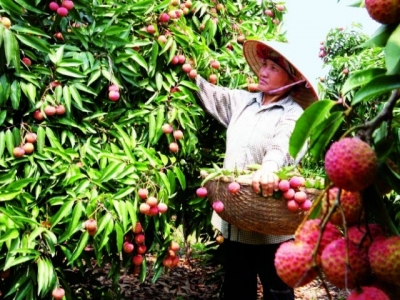Vietnam becomes supply hub with record agricultural exports

In 2017, despite numerous difficulties, including unfavorable natural conditions and marketing challenges, the agricultural sector expected to record a three-percent growth rate compared with 2016. The export value of agricultural, forest and aquatic products was expected to reach a record US$35 billion. Exports of fruit, vegetables, seafood and wood were particularly successful in 2017.
Fruit and vegetable exports have reached a record high
Three percent GDP growth
In 2017, the export value of most agricultural products, except rice, surged. The gross domestic product (GDP) of the entire agricultural sector was expected to grow three percent compared with 2016. The export value of agricultural, forest and aquatic products was expected to reach US$35 billion, up US$2.82 billion. Experts attributed these optimistic forecasts to nonstop efforts by state authorities, farmers, and especially the participation of businesses in the formation of agricultural value chains to meet market demand.
In the first 11 months, fruit and vegetables topped the list of agricultural exports, with value exceeding US$3 billion for the first time, a rise of 43.2 percent compared with the same period in 2016. Since the beginning of 2017, many kinds of Vietnamese fruit have entered the most discerning markets. Australia and New Zealand have allowed imports of dragon fruit from Vietnam. Star apples and mangoes have reached US shelves, and passion fruit has been exported to France. The 2017 export value of fruit and vegetables was forecast to reach US$3.6 billion, giving Vietnam a competitive edge in the global market.
In early 2017, the seafood sector set an annual export value target of US$7.4 billion, but towards the end of the year, breakthroughs in exports to new markets indicated that the target would be exceeded and possibly reach US$8 billion. These results reflect business efforts to prove the origin and quality of their products and seek new export markets for key products, such as shrimp and tra fish. Nguyen Ngoc Oai, Deputy General Director of the Ministry of Agricultural and Rural Development’s Directorate of Fisheries, said 2017 seafood exports were expected to reach about US$8 billion in value.
Wood exports were another bright spot on the 2017 agricultural export picture. Nguyen Ton Quyen, President of the Vietnam Timber and Forest Product Association, said wood exports were expected to reach US$7.5 billion in 2017. He attributed the success to increased business investment in processing to improve output and achieve higher export value.
2018 forecasts
Reviewing the results of trade in agricultural products in 2017, Field Crops Research Institute Deputy Director Dao The Anh said the domestic agricultural sector kept up with global market demand despite numerous difficulties.
Specialization has been promoted to improve product quality. “Vietnam can become one of the major agricultural supply hubs of the region and the world. This is a good market signal helping stabilize prices and enhance added value for farmers,” he added.
Experts believe there’s still room for Vietnam to increase the export of agricultural, forest and aquatic products. The export of fruit mostly in their raw forms brings low added value. In the opinion of Nguyen Huu Dat, Secretary General of the Vietnam Fruit and Vegetable Association, businesses should make further efforts to improve the quality and ensure the safety of Vietnamese fruit in order to negotiate higher export prices. They should also increase investment in processing to diversify export products, he added.
Regarding aquatic products, Nguyen Ngoc Oai said although Vietnam has advantages in developing aquaculture, the average yield per square meter remains low. The seafood sector needs to surmount this weakness and concentrate on expanding the breeding of brackish water shrimp and tra fish, as well as the production of unique regional aquatic products.
Minister of Agriculture and Rural Development Nguyen Xuan Cuong says the agricultural sector is determined to develop production chains and intensify processing, while at the same time seeking new export markets. He has emphasized the necessity of ensuring product quality to meet the demand of the domestic market with its 92 million consumers and the global market with seven billion consumers.
Bright points in the 2017 export picture encouraged the agricultural sector to set higher targets for coming years to achieve a higher growth rate and increase its contributions to the Vietnamese economy.
Field Crops Research Institute Deputy Director Dao The Anh:
There are good market signals for agricultural, forest and aquatic exports in 2018, especially for fruit, vegetables, seafood and wood. The agricultural sector needs to concentrate on improving product quality and safety to boost exports and increase added value.
Related news
 Positive signs for Vietnam's rice exports
Positive signs for Vietnam's rice exports Vietnam’s rice export industry has a bright future with good contracts after having a successful year.
 Vietnam’s path to become world cashew king
Vietnam’s path to become world cashew king Vietnam has overcome India, the world’s largest and long standing cashew nut processing and export nation for 12 years, and now continues leaving the country
 Root microbiome valuable key to plants surviving drought
Root microbiome valuable key to plants surviving drought Plants that can recruit particular bacteria to their root microbiomes are much more drought resistant than fellow plants.